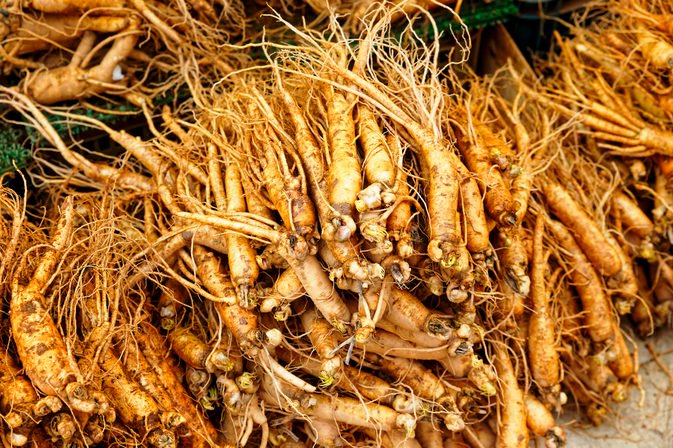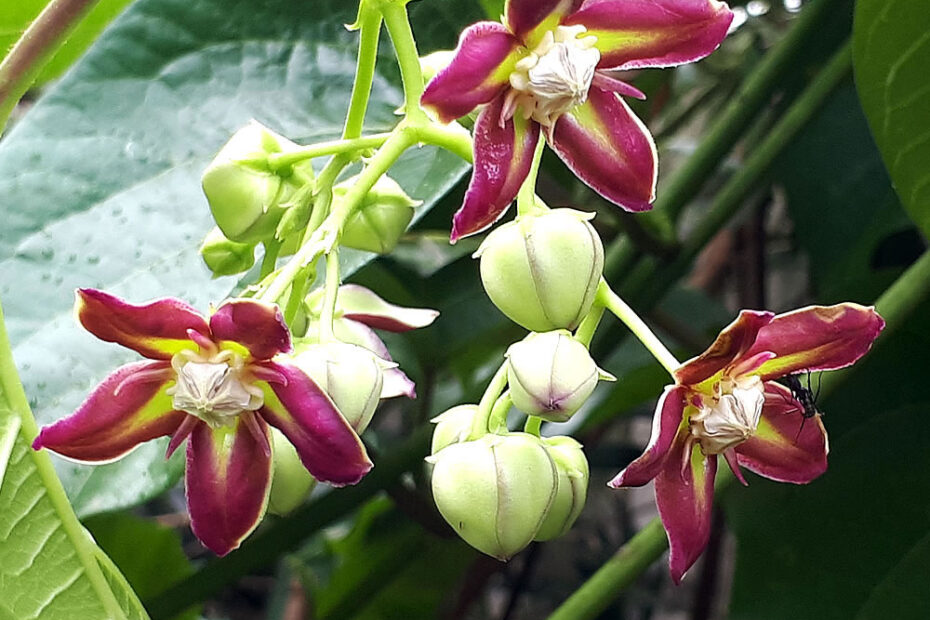Herbal Profile: Mondia whitei (White’s Ginger, Tonic Root)
Botanical Name: Mondia whitei (Hook.f.) Skeels
Family: Apocynaceae
Common Names: White’s Ginger, Tonic Root, African Ginger, Umondi (Zulu), Mukombero (Kenya), Gondolosi (Chichewa), Mulondo, Mundondo, and others across African regions.
Geographical Distribution: Endemic to sub-Saharan Africa, found in South, Central, East, and West Africa, including South Africa (KwaZulu-Natal, Limpopo), Senegal, Nigeria, Cameroon, Sudan, Uganda, Kenya, Tanzania, Zimbabwe, Malawi, Mozambique, Eswatini, and Angola. Grows at elevations of 1000-1500 m in moist to wet forests, woodlands, and swampy grasslands [1].
Botanical Description
- Type: Perennial, woody, vigorous climber reaching 3-8 m high with twining stems that exude white latex when cut.
- Root: Large, tuberous rootstock with a ginger or liquorice taste and a vanilla-like aroma.
- Leaves: Large, glossy, heart-shaped with reddish-purple veins and soft hairs on the surface. Positioned oppositely with star-shaped stipules.
- Flowers: Large, short-lived (3-4 days), reddish-purple with yellowish-green margins, arranged in branched inflorescences. They have a fruity but unpleasant scent, intensifying in the afternoon, likely pollinated by flies.
- Fruit: Woody pods containing up to 300 seeds, historically used for arrow poisons.
- Flowering Period: October-March (southern regions), May-August (northern regions).
- Growth: Slow-growing, taking up to 15 years to mature, frost-intolerant, prefers moist, well-drained soils (sandy, loamy, or clay) with semi-shade or full sun [2].
Traditional Uses
Mondia whitei is deeply embedded in African traditional medicine and culinary practices:
-
Medicinal Uses:
- Aphrodisiac: Widely used to enhance libido, treat erectile dysfunction, and improve male fertility by increasing testosterone, relaxing corpus cavernosum tissue, and enhancing sperm function. Comparable to Sildenafil (Viagra) in stimulating nitric oxide release [3].
- Digestive Health: Roots chewed or brewed as tea to stimulate appetite, treat anorexia, and alleviate stomach pain, gastrointestinal disorders, and indigestion. Used as an antacid [4].
- Stress and Mental Health: Exhibits antidepressant, antiepileptic, and anticonvulsant properties, with moderate serotonin reuptake inhibition. Used to relieve stress, tension, and improve sleep quality [5].
- Other Conditions: Traditionally used for hypertension, stroke, anaemia, asthma, allergies, colds, flu (reduces histamine production), eczema, ringworms, urinary tract infections, jaundice, headaches, and gonorrhoea [6].
- Galactagogue: Used to promote lactation in women [7].
-
Culinary Uses:
- Roots have a bitter taste with a sweet, vanilla-like aftertaste, used to flavour beverages like ginger beer or alcoholic drinks for ceremonies (e.g., weddings). Described as tasting like liquorice, marzipan, cinnamon, or vanilla [8].
- Leaves are eaten as a spinach substitute in South African and Angolan cuisines.
- Roots and dried leaves are powdered for use as a spice or health supplement.
-
Other Uses:
- Stems provide strong fibres for weaving ropes.
- Historically, seeds were used to make arrow poisons [9].
Phytochemistry
Mondia whitei contains bioactive compounds contributing to its medicinal properties:
- Key Compounds: Alkaloids, saponins, flavonoids, glycosides, resins, volatile and fixed oils, and a chlorinated coumarinolignan.
- Nutrients: Rich in nutrients; minerals including zinc, iron, calcium, magnesium, and selenium; and crude “protein” (20.25% in leaves, higher than some animal feeds) [10].
- These compounds support its anti-inflammatory, antioxidant, antimicrobial, anthelmintic, and aphrodisiac effects [11].

Pharmacological Evidence
Scientific studies validate many traditional uses:
- Aphrodisiac Effects: Increases testosterone, enhances sperm motility, and improves erectile function by stimulating nitric oxide release, similar to Viagra [12].
- Antidepressant Properties: Leaves and flowers show moderate serotonin reuptake inhibition, supporting use in mental health [13].
- Anti-inflammatory and Antioxidant: Potential to treat inflammatory conditions like arthritis and reduce oxidative stress [14].
- Antimicrobial and Anthelmintic: Roots exhibit activity against schistosomiasis and other pathogens [15].
- Cognitive Benefits: Preliminary studies suggest improved memory and potential for treating neurological disorders [16].
- Safety: Generally safe when used traditionally, but excessive consumption may cause gas, heartburn, or mouth ulcers. Allergic reactions (redness, rashes) are rare. Consultation with a healthcare professional is advised, especially for pregnant/lactating women or those with medical conditions [17].
Conservation Status
-
Threats: Listed as Endangered due to overharvesting, particularly of roots, which destroys the plant. Reported extinct in the wild in South Africa’s Tugela River region and scarce in Kenya’s Kakamega Forest. Habitat loss exacerbates decline [18].
- Conservation Efforts: Initiatives include on-farm cultivation, micropropagation, and hairy root biotechnology to reduce pressure on wild populations. Projects in Kenya (e.g., Kakamega) and South Africa promote sustainable harvesting and commercialisation [19].
Cultivation and Commercial Potential
- Growth Requirements: Prefers moist, well-drained soils, semi-shade to full sun, and tropical/subtropical climates. Hardy to USDA zone 10 [20].
- Commercialisation: Used in cosmeceutical, nutraceutical, and pharmaceutical industries. Available as powders, capsules, teas, and blends (e.g., with Tongkat Ali or Fadogia agrestis) for libido and vitality [21].
- Challenges: Slow growth (15 years to maturity) and overexploitation hinder sustainable supply. Cultivation projects aim to address this [22].
Preparation and Usage
- Roots: Chewed raw, brewed as tea, or powdered for supplements. Tea is consumed 2–3 hours before sexual activity or as a daily tonic.
- Leaves: Eaten fresh, cooked as a vegetable, or dried/powdered for decoctions.
- Dosage: Limited data on standardised dosing; traditional use suggests moderation. Consult a healthcare provider for frequent use [23].
Precautions and Side Effects
- Side Effects: Rare but may include gas, heartburn, mouth ulcers, or allergic reactions (redness, rashes).
- Contraindications: Pregnant or lactating women, diabetics, and those with known medical conditions should consult a physician. May interact with certain medications [24].
- Allergen Warning: Processed in facilities handling dairy, soy, nuts, or grains, posing cross-contamination risks [25].
Cultural Significance
Mondia whitei is deeply rooted in African traditions, reflected in its many names (e.g., òjidi m ogbu agu in Igbo, meaning “kola nut for my hunter-husband”). It is used in ceremonies like weddings and as a tonic for hunters. Its versatility as a medicinal, culinary, and cultural plant underscores its value across African communities [26].
Conclusion
Mondia whitei is a multifaceted herb with significant medicinal, culinary, and cultural roles in African traditions. Its aphrodisiac, antidepressant, and nutritional properties are supported by scientific evidence, but overharvesting threatens its survival. Sustainable cultivation and conservation are critical to preserving this “magical” herb for future use. Always consult a healthcare professional before use, especially for medicinal purposes.
References
[1] Cunningham, A.B., & Mbenkum, F.T. (1993). Sustainability of harvesting Mondia whitei in Cameroon.
[2] McGeoch, M.A., & Chown, S.L. (2001). Botanical characteristics of Mondia whitei.
[3] Watcho, P., et al. (2007). Aphrodisiac effects of Mondia whitei in rats.
[4] Kokwaro, J.O. (2009). Medicinal Plants of East Africa.
[5] Nielsen, N.D., et al. (2012). Antidepressant properties of Mondia whitei.
[6] Neuwinger, H.D. (1996). African Ethnobotany: Poisons and Drugs.
[7] Van Wyk, B.E., & Gericke, N. (2000). People’s Plants: A Guide to Useful Plants of Southern Africa.
[8] Hutchings, A., et al. (1996). Zulu Medicinal Plants.
[9] Schmelzer, G.H., & Gurib-Fakim, A. (2008). Medicinal Plants 1.
[10] Oketch-Rabah, H.A. (2012). Phytochemical analysis of Mondia whitei.
[11] Gbadamosi, I.T., & Aboaba, S.A. (2016). Bioactive compounds in Mondia whitei.
[12] Lampiao, F., et al. (2008). Spermatogenic effects of Mondia whitei.
[13] Pedersen, M.E., et al. (2014). Serotonin reuptake inhibition by Mondia whitei.
[14] Dzoyem, J.P., et al. (2014). Anti-inflammatory activity of Mondia whitei.
[15] Ojewole, J.A.O. (2005). Antimicrobial properties of Mondia whitei.
[16] Ameyaw, Y., & Duker-Eshun, G. (2009). Neuroprotective effects of Mondia whitei.
[17] Fennell, C.W., et al. (2004). Safety evaluation of Mondia whitei.
[18] Crouch, N.R., & Symmonds, R. (2001). Conservation status of Mondia whitei in South Africa.
[19] Aremu, A.O., & Van Staden, J. (2013). Micropropagation of Mondia whitei.
[20] Brink, M., & Achigan-Dako, E.G. (2012). Cultivation of Mondia whitei.
[21] Mander, M., & Le Breton, G. (2006). Commercial potential of Mondia whitei.
[22] Ndhlala, A.R., et al. (2010). Sustainable harvesting of Mondia whitei.
[23] Maroyi, A. (2017). Traditional use and dosage of Mondia whitei.
[24] Bussmann, R.W., & Sharon, D. (2006). Contraindications of African medicinal plants.
[25] Van der Walt, L. (2009). Allergen risks in Mondia whitei processing.
[26] Iwu, M.M. (2014). Handbook of African Medicinal Plants.
This article is copyrighted by Ital is Vital, 2025. Want to re-post this article? Visit our guidelines.
DISCLAIMER: THIS WEBSITE DOES NOT PROVIDE MEDICAL ADVICE
The information, including but not limited to, text, graphics, images and other material contained on this website are for informational purposes only. The purpose of this website is to promote broad consumer understanding and knowledge of various health topics. It is not intended to be a substitute for professional medical advice, diagnosis or treatment. Always seek the advice of your physician or other qualified health care provider with any questions you may have regarding a medical condition or treatment and before undertaking a new health care regimen, and never disregard professional medical advice or delay in seeking it because of something you have read on this website.
